At last, 5 months after our move, I'm caught up on enough things and have unpacked and setup my reloading area.

It felt fantastic to actually load some new rounds this weekend. I didn't finish a lot of them, but did complete enough for testing new caliber and loads in the new rifle I bought last year (wow, actually in late 2020). For previous story on this beautiful Sako model 85 Rifle, see the previous post here:
https://peakd.com/hive-139358/@ksteem/a-birthday-rifle-story
I cleaned and prepped about 80 of my .338 Lapua Magnum brass, and about 120 of the .22-250 Remington brass.
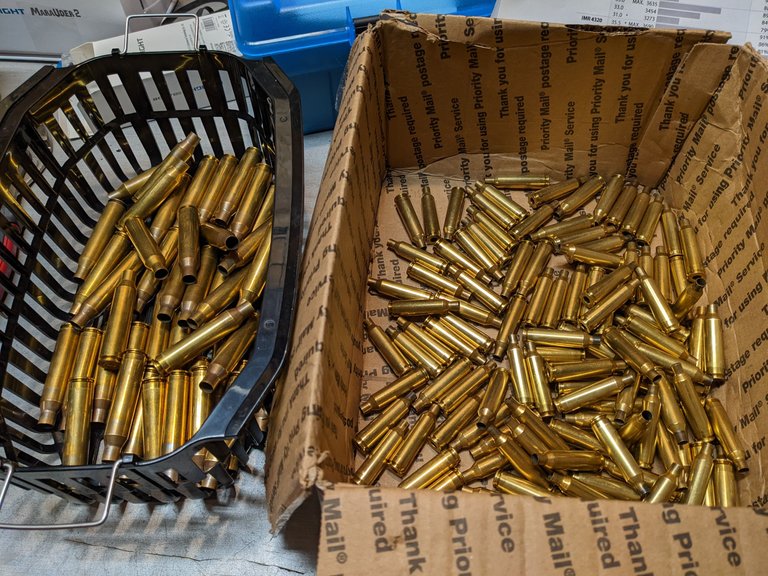
I spent some time yesterday de-priming, resizing, and then running the brass through a sonic cleaner to remove the carbon deposits. I realized I didn't have any solvent (substituted some Dawn dish soap) and couldn't find my Lemi-shine so they are not real shiny, but at least they are clean. The sonic cleaner even does a good job on the primer pockets, but not near as shiny as @galenkp gets with his nice tumbler. I'm thinking that may be an upgrade this year.
Then we went into the oven to dry (I don't have a fancy dehydration unit either).
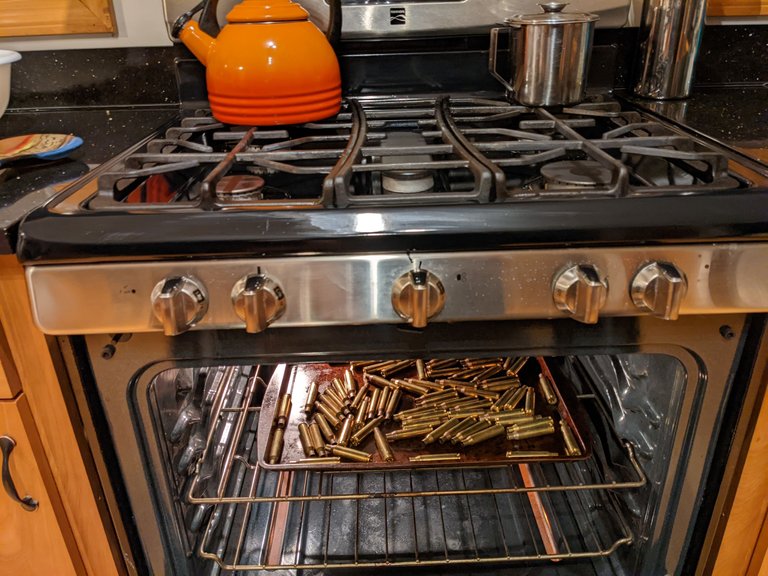
Next was determining what load to use. The 22-250 is a new caliber for me to reload. As you can see from the chart below, there are lots of options to consider when reloading. The first is bullet weight, type, and shape. Different weights and types may not shoot well in all rifles. For example my Lapua likes heavier bullets. With 250-300 grain bullets, it's a solid MOA (Minute of Angle) (Less than 1 inch at 100 yard groups) weapon. With lighter 180 grain bullets, it's lucky to keep them within 16 inches.
For this rifles barrel length, twist rate and intended use, I chose Nosler "Varmageddon" 55 grain bullets. This combo should shoot bullets from 50-60 grains well, so I chose in the middle to start with (and because that's what was available). These have a hollow-point design with a "ballistic tip" insert that gives it that pointy tip for better aerodynamics, and accuracy improvements over distance than an open hollow-point. This bullet is made primarily for hunting out west and fragments tremendously on impact, greatly reducing risk of ricochet and producing impressive terminal performance on small/medium size game. The ballistic tip also gives it good accuracy. This dual purpose serves my needs well.
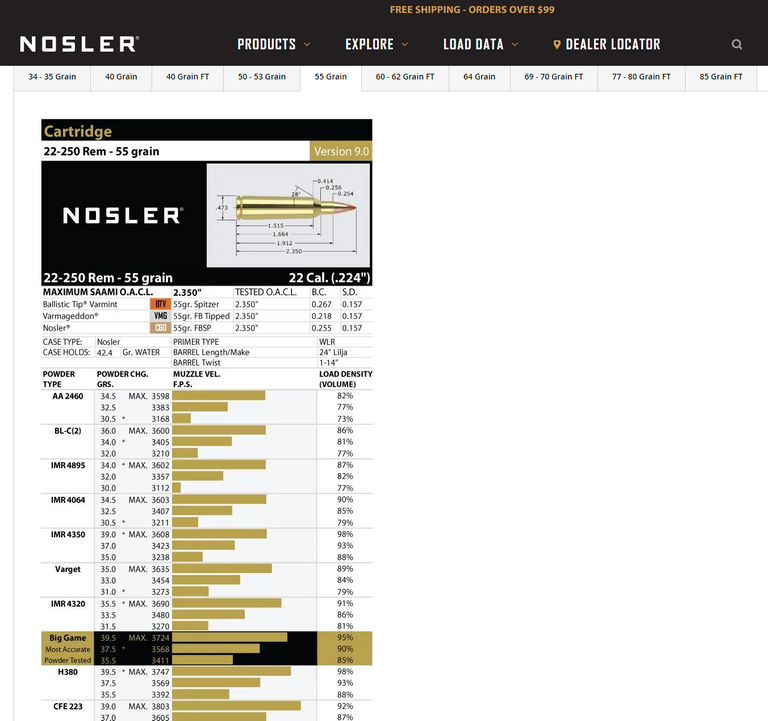
This Chart picture courtesy of Nosler.com website. All others my own.
As you can see from the Nosler chart. there are then many choices of powder and even using different amounts of powder for different bullet weights or purposes. Higher loads of powder result in higher velocities, but also have more recoil than lower loads. Also the highest, fastest load isn't always the most accurate. I tend to start at the fastest, most accurate load, and then tweak it up or down a bit for actual real-world performance. Most people aren't shooting the exact same barrel model or length that they use for the factory ratings, so testing is needed to adjust for the variations. My initial choice was "Varget" powder which seems to be one of the favorites for this caliber, but haven't been able to get that over here for over a year now. I ended up finding some IMR 4895 last year as a second choice, and was able to get a few pounds to get started.
This tuning is not needed for all people. I enjoy the never ending search for improvement and perfection. Any of the recommended factory loads will still function and usually perform as accurate as off-the-shelf ammunition. But I like to get my rifles down to where they can double (halve?) that MOA performance, ie: I want them to shoot groups an inch at 200 yards or farther, half an inch or even a quarter inch at 100 yards.
The scale shown in the initial picture was an upgrade for me two years ago. This powder seems to work really well in it. I just punch in the weight, and the scale dumps the proper amount into the tray. The little tube sticking out above the powder tray is called a "trickler". Once you calibrate the scale, you simply punch in the weight of powder you want and it "auto-trickles" the correct amount into the tray by spinning the little tube, and then beeps when done. It's fairly accurate, but also tells you if it is over or under weight. For example out of the 20 loads I did today, three of them were slightly off. Two of them were "over" by a tenth of a grain, and one of them was "under" by a tenth of a grain. This is still really good, with some of my other powder, I've seen it off by as much as 2-3 grains.
As picky as I am, I am measuring each load to within a tenth of a grain or less deviation with the hopes that this will keep velocities within single digit deviations when shooting time comes. This is the big difference between handloads and factory ammo, which of course are mass-produced by machines. Here, you can see how small the three grains of powder are compared to a ball-point pen.
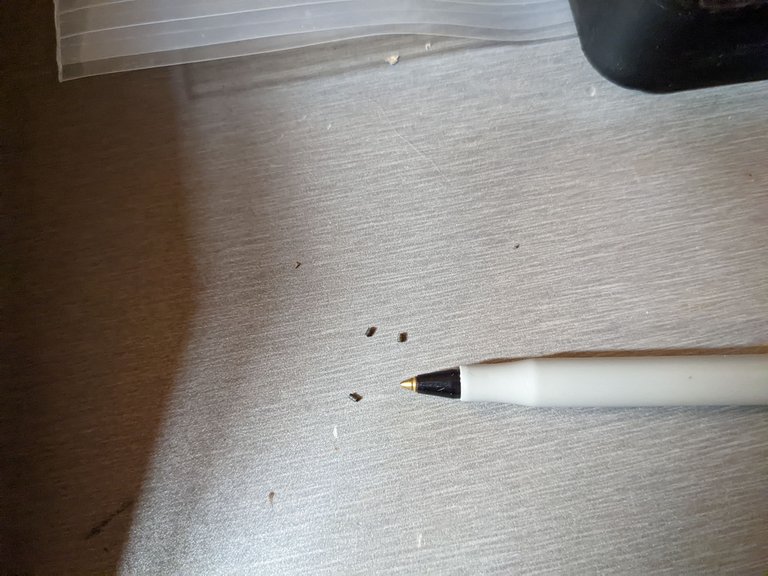
Now to determine the most accurate load for my rifle, I'm using the published chart as a starting point, then loading 5 rounds each at various powder levels, 32 grains, 33 grains, 34 grains, and 34.5 grains. I'll then shoot 5 shot groups with each and see which performs best while also gathering accurate velocity data using a chronograph. Also to compare against the factory ammo which I know from previous testing had high double and even triple digit deviations in velocity. More on that comparison later.
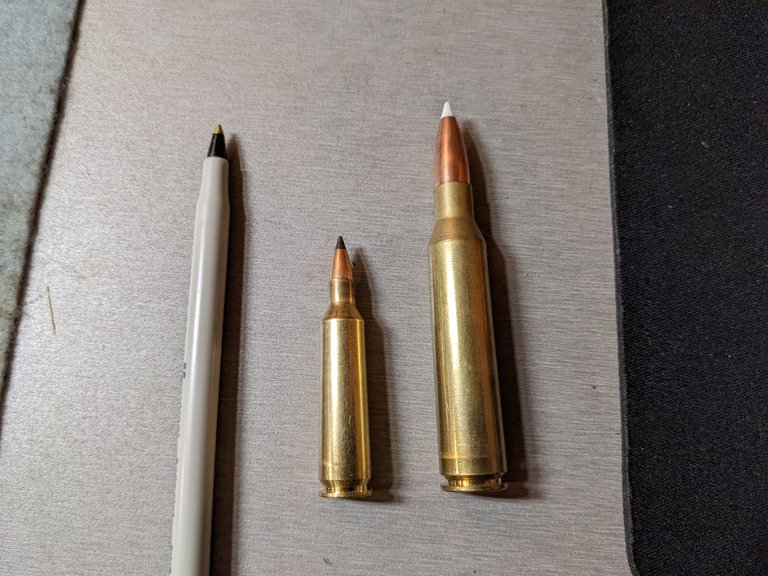
Here is the finished result, one of each caliber for comparison. Now I just need the construction guys to finish my garage so I can unpack all my tools and get some frames built to hold the paper targets for the accuracy testing!
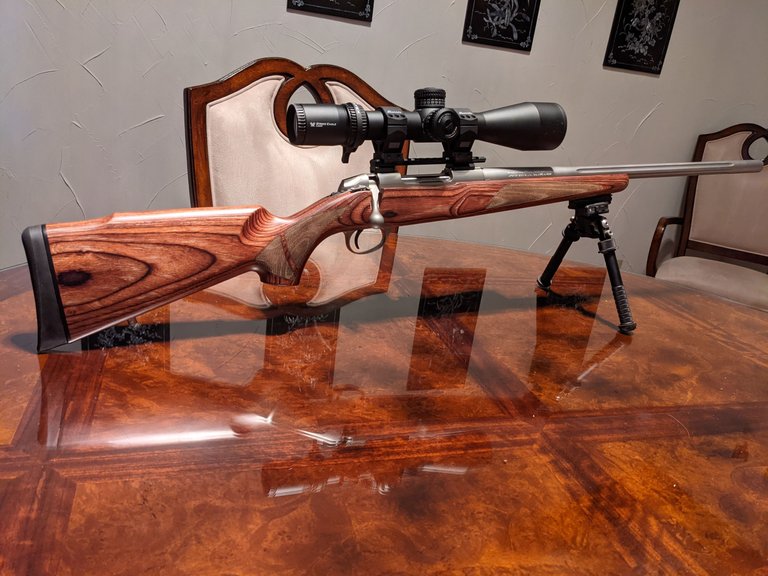
View or trade
BEER.Hey @ksteem, here is a little bit of
BEERfrom @pixresteemer for you. Enjoy it!Learn how to earn FREE BEER each day by staking your
BEER.Congratulations @ksteem! You have completed the following achievement on the Hive blockchain and have been rewarded with new badge(s):
Your next target is to reach 19000 upvotes.
You can view your badges on your board and compare yourself to others in the Ranking
If you no longer want to receive notifications, reply to this comment with the word
STOPTo support your work, I also upvoted your post!
Check out the last post from @hivebuzz:
hi @ksteem... how are you,, I hope you are well,, I am very impressed with the firearms that you show this time, but I am more interested in the laser that you put on top of the firearm,, the price must be very expensive...?????
Hi, I'm guessing you mean scope, it's not a laser. It's a Vortex Strike Eagle 5-25 x56 MRAD FFP. It's what I consider one at the top-end of midrange scopes. It's not quite as good as a Zeiss, Kahle's, Schmidt and Bender, but it's less than half the cost of some of those. It has lifetime guarantee, good glass, and has been tracking solid. I have 3 of these and one PST now on various rifles, all are working great. Around 800 I believe if you catch them on sale.
Yes, I mean binoculars, thank you for the information, the price will definitely drain your wallet, hehehe